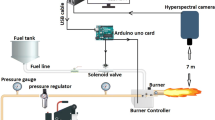Abstract
In order to improve flame stabilization in small scale combustors, there have been many research works going on non-premixed as well as on premixed flame. The present experimental study characterizes colour and shape of the premixed and non-premixed flames through a laminar co-flow burner. Various flame behaviors are observed and their stabilization limits are investigated at different fuel–air ratios. The spectroscopic approach becomes suitable method for the measurement of chemiluminescensce for both premixed and diffusion flames. Thus, we can predict the behavior of a combustion process. We observe also the intensity variation of chemiluminescence species, OH*, CH*, and C2* for different fuel-air flow combinations. Apart from that, we have an analysis of colour variance of the premixed flame for different flame locations.








Similar content being viewed by others
Abbreviations
- Re:
-
Reynolds number
References
Richards G A, McMillian M M, Gemmen R S, Rogers W A and Cully S R 2001 Issues for low-emission, fuel-flexible power systems. Progr. EnergyCombust. Sci. 27(2): 141–169
Martins C A, Pimenta A P, Carvalho Jr J A, Ferreira M A and Caldeira-Pires A A 2005 CH and C2 radical characterization in natural gas turbulent diffusion flames. Mech. Sci. Eng. 27(2): 110–118
De S, Bhattacharya A, Mondal S, Mukhopadhyay A and Sen S 2018 Investigation of flame behavior and dynamics prior to lean blowout in a combustor with varying mixedness of reactants for the early detection of lean blowout. Int. J. Spray Combust. Dyn. 1756827718812519
Gangopadhyay T, De S, Biswas A, Saha A, Mukhopadhyay A and Sen S 2016 Recurrence Analysis of Dynamics of Premixed and Partially Premixed Flames near Lean Blowout. In: Conference on Nonlinear Systems and Dynamics IISER Kolkata. 16: 18
Gore J P and Zhan N J 1996 NOx emission and major species concentrations in partially premixed laminar methane/air coflow jet flames. Combust. Flame 105(3): 414–427
Miller I M and Maahs H G 1977 High-pressure flame system for pollution studies with results for methane–air diffusion flames
Lee K and Ryu J 2005 An experimental study of the flame propagation and combustion characteristics of LPG fuel. Fuel 84(9): 1116–1127
Sato Y 2000 Research Trend in Power System using Alternative Fuels. IWPS2000. 27–30
Mishra D P and Rahman A 2003 An experimental study of flammability limits of LPG/air mixtures. Fuel 82(7): 863–866
Demirbas A 2002 Fuel properties of hydrogen, liquefied petroleum gas (LPG) and compressed natural gas (CNG) for transportation. Energy Sources 24(7): 601–610
Hossain A andNakamura Y 2014 A numerical study on the ability to predict the heat release rate using CH* chemiluminescence in non-sooting counterflow diffusion flames. Combustion and flame 161(1): 162–72
Docquier N and Candel S 2002 Combustion control and sensors: a review. Progr. Energy Combust. Sci. 28(2): 107–150
Arias L, Torres S, Sbarbaro D and Farias O 2008 Photodiode-based sensor for flame sensing and combustion-process monitoring. Appl. Opt. 47(29): 5541–5549
Ballester J and García-Armingol T 2010 Diagnostic techniques for the monitoring and control of practical flames. Progr. Energy Combust. Sci. 36(4): 375–411
Candel S 2002 Combustion dynamics and control: progress and challenges. Proc. Combust. Inst. 29(1): 1–28
Samaniego J M and Mantel T 1999 Fundamental mechanisms in premixed turbulent flame propagation via flame–vortex interactions: Part I: Experiment. Combust. Flame 118(4): 537–556
Hardalupas Y and Orain M 2004 Local measurements of the time-dependent heat release rate and equivalence ratio using chemiluminescent emission from a flame. Combust. Flame 139(3): 188–207
De S, Sarkar S, Munshi J, Bhattacharya A, Mukhopadhyay A and Sen S 2017 An experimental study on extinction and stability of counter flow non-premixed flames. In: 25th National Conference on Internal Combustion Engines and Combustion (NCICEC2017)
Ballester J, Sanz A, Hernández R and Smolarz A 2005 Detection and Analysis of Emitted Radiation for Advanced Monitoring and Control of Combustors In: Photonics Applications in Industry and Research IV. 5948: 59482H
Cheng T S, Wu C Y, Li Y H and Chao Y C 2006 Chemiluminescence measurements of local equivalence ratio in a partially premixed flame. Combust. Sci. Technol. 178: 1821–1841
Nori V N and Seitzman J M 2007 Chemiluminescence measurements and modeling in Syngas, methane and Jet-A fueled combustors. In: 45th AIAA Aerospace Sciences Meeting and Exhibit. 466
Nori V N and Seitzman J M 2009 CH* chemiluminescence modeling for combustion diagnostics. Proc. Combust. Inst. 32(1): 895–903
Docquier N, Lacas F and Candel S 2002 Closed-loop equivalence ratio control of premixed combustors using spectrally resolved chemiluminescence measurements. Proc. Combust. Inst. 29(1): 139–145
Muruganandam T M, Kim B H, Morrell M R, Nori V N, Patel M, Roming B W and Seitzman J M 2005 Optical equivalence ratio sensors for gas turbine combustors. Proc. Combust. Inst. 30(1): 1601–1609
Huang H W, Zhang Y 2011 Digital colour image processing-based measurement of premixed CH4 + air and C2H4 + air flame chemiluminescence. Fuel 90(1): 48–53
Krabicka J, Lu G and Yan Y 2011 Profiling and characterization of flame radicals by combining spectroscopic imaging and neural network techniques. IEEE Trans. Instrum. Meas. 60(5): 1854–1860
Wang Y, Makwana A, Iyer S, Linevsky M, Santoro R J, Litzinger T A and O’Connor J 2018 Effect of fuel composition on soot and aromatic species distributions in laminar, co-flow flames. Part 1. Non-premixed fuel. Combust. Flame 189: 443–455
Sahu K B, Kundu A, Ganguly R and Datta A 2009 Effects of fuel type and equivalence ratios on the flickering of triple flames. Combust. Flame 56(2): 484–493
Acknowledgement
This paper is a revised and expanded version of an article entitled, “EXPERIMENTAL STUDY ON LPG–AIR MIXED FLAME IN LAMINAR CO-FLOW BURNER”, Paper No., “57” presented in “First International Conference on Mechanical Engineering” held at ‘Jadavpur University’, Kolkata, India during January 4–6, 2018.
Author information
Authors and Affiliations
Corresponding author
Rights and permissions
About this article
Cite this article
Kotal, M.R., De, S., Das, S. et al. Characterization of laminar flame using high speed camera and spectrometer. Sādhanā 45, 230 (2020). https://doi.org/10.1007/s12046-020-01465-4
Received:
Revised:
Accepted:
Published:
DOI: https://doi.org/10.1007/s12046-020-01465-4




